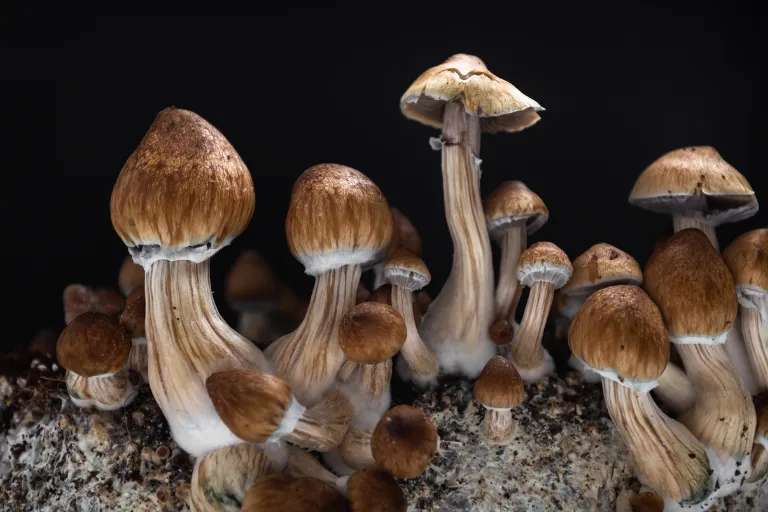Key Points
- Microdosing psilocybin—typically 100–300 mg dried Psilocybe cubensis mushrooms—is often taken on schedules like the Fadiman (one day on, two off) or Paul Stamets stacking protocols (Daytryp, 2023).
- Double‑blind controlled studies, such as the one led by Szigeti et al. at Imperial College London (2021), suggest many reported mood changes may be due to expectancy effects, with objective cognitive gains remaining limited.
- Large-scale self-reported surveys, including data from the citizen science platform Quantified Citizen (Polito & Stevenson, 2019), find modest reductions in depressive states, anxious thoughts, and stress—but these studies are observational and uncontrolled.
- Proposed mechanisms include modulation of serotonin 5‑HT2A receptors and increased neuroplasticity, mechanisms more strongly supported in high-dose studies (Carhart-Harris & Friston, 2019).
- Safety is not fully established; mild side effects are reported, and there are unanswered questions around contraindications, long‑term use, and legal risks.
A Pinch of Mushrooms, a World of Possibilities?
What if a pinch of mushrooms—just a few hundred milligrams—could lift your mood, sharpen your focus, or boost your creativity? In recent years, microdosing psilocybin mushrooms has attracted a quiet yet growing following. Advocates share stories of subtle but meaningful improvements in emotional resilience. But does the science support these claims—or are they mostly in our heads?
Why Microdosing Is Getting So Much Attention
Mood regulation challenges are widespread, from workplace stress to lingering depressive states. With growing interest in alternative mental wellness strategies—and frustration with the side effects or limited results of conventional therapies—many people are exploring microdosing. It offers an appealing possibility: mood‑enhancing effects without a full psychedelic trip. Yet microdosing remains controversial, legally restricted in most places, and scientifically unsettled.
The Struggles People Hope to Ease
Those drawn to microdosing often describe:
- Persistent low mood or emotional flatness
- Decreased motivation or creative drive
- Concern about stigma or side effects from conventional medications
For some, microdosing is seen as a subtle alternative—something that might help mood or spark emotional flexibility without sedation or perceptual changes.
How Psilocybin Works in the Brain
Tuning serotonin pathways
Psilocybin acts primarily at serotonin 5‑HT2A receptors, which influence mood, perception, and emotional tone (Nichols, Pharmacological Reviews, 2016). While macrodose studies show robust mood improvement, microdosing is thought to modulate the same pathways at sub‑perceptual levels.
Possible neuroplasticity boost
Research on higher doses, such as the work by Carhart-Harris and colleagues at Imperial College London (Cell Reports, 2021), points to increased neural flexibility, synaptic growth, and altered connectivity in brain networks involved in mood and creativity. It is theorized—though not yet proven—that microdosing may produce milder versions of these effects.
The placebo problem
In a randomized, double‑blind, placebo-controlled trial, Szigeti et al. (eLife, 2021) found that participants taking microdoses reported mood enhancements, but cognitive performance did not significantly improve compared to placebo. Many effects could be explained by unblinding and expectation bias.
How People Actually Microdose
Common Schedules and Amounts
- Fadiman protocol: ~0.1 – 0.3 g dried mushrooms (≈100–300 mg), one day on, two days off (Fadiman, The Psychedelic Explorer’s Guide, 2011).
- Stamets stack: Similar doses combined with lion’s mane mushrooms and niacin, often taken four days on, three off (Stamets, 2017).
- Potency varies by species, growing conditions, and whether mushrooms are dried or fresh.
Safety and Harm Reduction Tips
- Use a precision scale or standardized extract to avoid accidental high doses (Microdelics Harm Reduction Guidelines, 2022).
- Keep a journal tracking mood, cognition, and side effects to reduce bias and monitor changes.
- Avoid microdosing if you have a history of psychosis or bipolar disorder, or if you are taking SSRIs or MAOIs, unless under the guidance of a health professional (Verywell Health, 2023).
- Start with the lowest effective dose and space sessions to minimize tolerance buildup.
The Law: Where Psilocybin Stands Today
- Psilocybin remains illegal under U.S. federal law and in most countries.
- Oregon has legalized regulated psilocybin services, and Colorado passed legislation for supervised therapeutic access.
- Several U.S. cities, including Denver and Oakland, have decriminalized personal possession (AP News, 2023).
- Outside these jurisdictions, purchasing or possessing mushrooms can carry significant legal risk.
What the Research Says About Mood Benefits
Large observational surveys—such as the 2019 study by Polito & Stevenson (PLOS ONE)—have found that microdosers self‑report lower depressive states, fewer anxious thoughts, and increased focus. More recent citizen science projects, including those run through Quantified Citizen, echo these findings across thousands of users.
However, controlled trials are more cautious. Szigeti et al.’s work showed subjective benefits but no significant cognitive performance improvement over placebo, and other trials have reported similarly mixed results. The gap between self-reported and controlled outcomes suggests a strong role for expectancy.
A Story from the Field
In a 2023 AP News feature, a U.S. veteran described feeling “more present” and emotionally steady after beginning a microdosing routine. Researchers quoted in the same piece cautioned that placebo effects could be contributing—but acknowledged that for some, even perceived improvements can feel meaningful.
Thinking of Trying It? Here’s How to Approach It Wisely
- Consult credible sources such as peer‑reviewed studies or reputable citizen science platforms.
- Begin with conservative doses, track effects diligently, and be aware of personal mental health history.
- Speak with a health professional, especially if you have existing mental health symptoms or take medication.
- Understand your jurisdiction’s laws before obtaining or using psilocybin.
The Takeaway
Microdosing psilocybin for mood improvement is an intriguing but still experimental practice. Controlled trials show limited measurable benefits, while observational reports are more positive but vulnerable to bias. For now, it remains a personal experiment that carries both subtle possibilities and meaningful unknowns. A cautious, informed approach—grounded in harm reduction and respect for legal boundaries—is essential until more definitive science emerges.
The article does not in any way constitute as medical advice. Please seek consultation with a licensed medical professional before starting any treatment. This website may receive commissions from the links or products mentioned in this article.
Subscribe for Free for more insightful health articles tailored to your needs.
References
- AP News. (2023). Microdosing mushrooms gaining traction despite legal and research hurdles. https://apnews.com/article/390c99ba54ef9d75727f39e2ec78fb34
- Carhart-Harris, R., & Friston, K. (2019). REBUS and the anarchic brain: Toward a unified model of the brain action of psychedelics. Pharmacological Reviews, 71(3), 316–344. https://doi.org/10.1124/pr.118.017160
- Carhart-Harris, R. et al. (2021). Effects of psilocybin on brain connectivity. Cell Reports. https://doi.org/10.1016/j.celrep.2021.108844
- Daytryp. (2023). Psilocybin microdosing: A comprehensive guide. https://daytryp.com/psilocybin/psilocybin-microdosing-a-comprehensive-2023-guide
- Fadiman, J. (2011). The Psychedelic Explorer’s Guide: Safe, Therapeutic, and Sacred Journeys. Park Street Press.
- Microdelics. (2022). Safe microdosing harm reduction. https://www.microdelics.org/learn/safe-microdosing-harm-reduction
- Nichols, D. E. (2016). Psychedelics. Pharmacological Reviews, 68(2), 264–355. https://doi.org/10.1124/pr.115.011478
- Polito, V., & Stevenson, R. J. (2019). A systematic study of microdosing. PLOS ONE. https://doi.org/10.1371/journal.pone.0211023
- Szigeti, B. et al. (2021). Self‑blinding citizen science to explore psychedelic microdosing. eLife, 10, e62878. https://doi.org/10.7554/eLife.62878
- Stamets, P. (2017). Paul Stamets Stack Protocol. Fungi Perfecti.
- Verywell Health. (2023). Microdosing: Safety, benefits, and risks. https://www.verywellhealth.com/microdosing-5271962
- Adeyinka, D., Forsyth, D., Currie, S., & Faraone, N. (2025). Neurobiology of psilocybin: A comprehensive overview and comparative analysis of experimental models. Frontiers in Systems Neuroscience, 19, 1585367. https://doi.org/10.3389/fnsys.2025.1585367
- Ona, G., & Bouso, J. C. (2020). Potential safety, benefits, and influence of the placebo effect in microdosing psychedelic drugs: A systematic review. Neuroscience & Biobehavioral Reviews, 119, 194–203. https://doi.org/10.1016/j.neubiorev.2020.09.035
- Polito, V., & Stevenson, R. J. (2019). A systematic study of microdosing psychedelics. PLOS ONE, 14(2), e0211023. https://doi.org/10.1371/journal.pone.0211023
- Rootman, J. M., Kryskow, P., Harvey, K., Stamets, P., Santos-Brault, E., Kuypers, K. P. C., Polito, V., Bourzat, F., Walsh, Z. (2021). Adults who microdose psychedelics report health-related motivations and lower levels of anxiety and depression compared to non-microdosers. Scientific Reports, 11, 22479. https://doi.org/10.1038/s41598-021-01811-4
- Rootman, J. M., et al. (2022). Psilocybin microdosers demonstrate greater observed improvements in mood and mental health at one month relative to non-microdosing controls. Scientific Reports, 12, 11091. https://doi.org/10.1038/s41598-022-14512-3
- Szigeti, B., Kartner, L., Blemings, A., et al. (2021). Self-blinding citizen science to explore psychedelic microdosing. eLife, 10, e62878. https://doi.org/10.7554/eLife.62878




